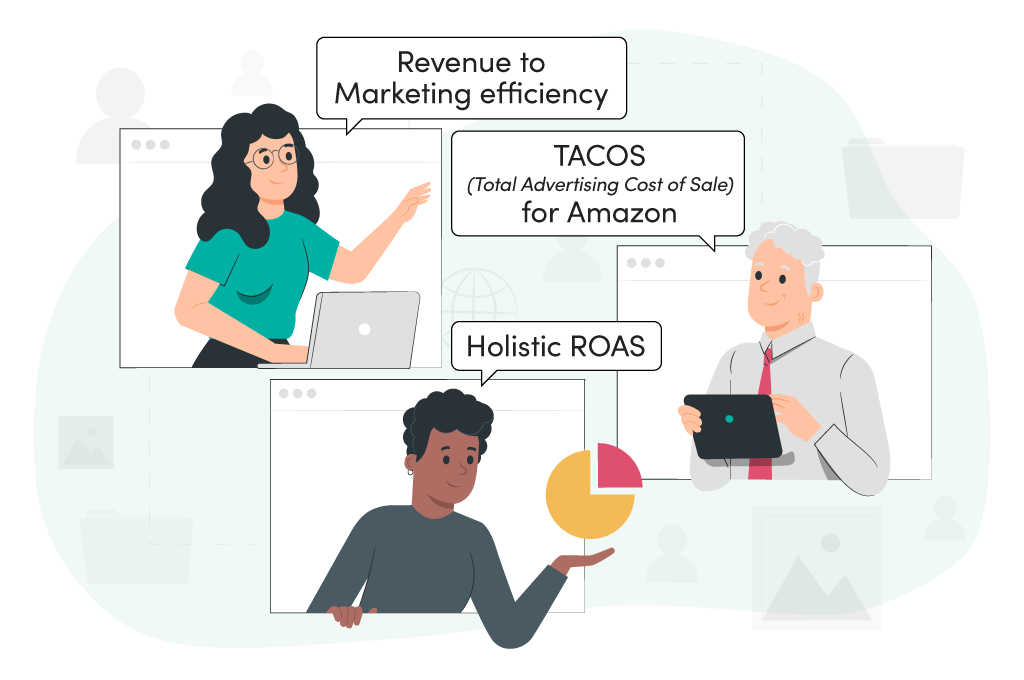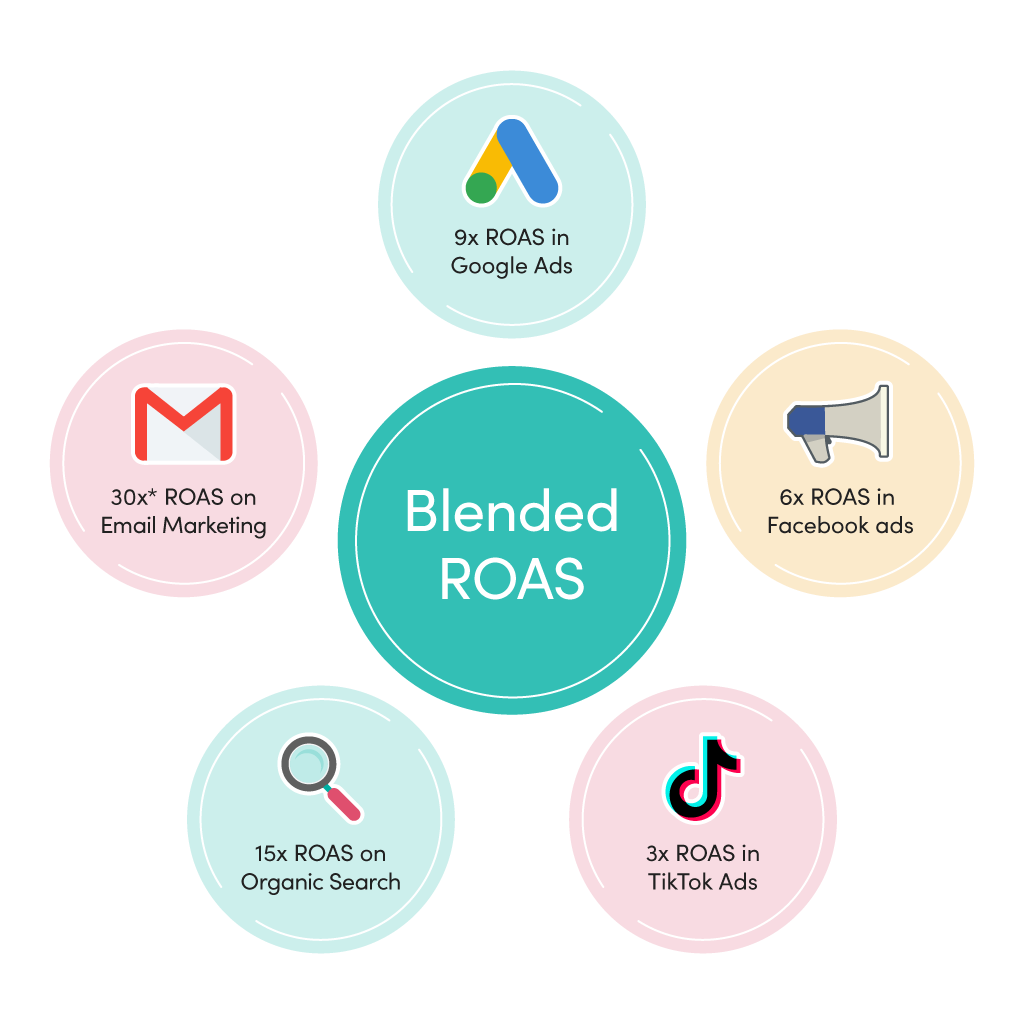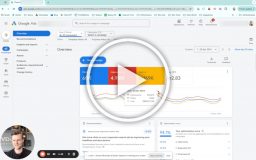Summary
- Tracking is getting more difficult, so we need alternatives to the traditional way of reviewing marketing channels
- An overreliance on channel tracking (FB Pixel, Google Conversion Tracking, etc.) can sometimes lead to mistaken attribution
- As your business grows, you should rely less on channel tracking and more on blended ROAS
- Blended ROAS gives you a macro overview of your total advertising cost vs. revenue
- Channel tracking becomes an indicator of performance rather than the final truth
- Taking untrackable revenue sources into account gives you a competitive advantage
Intro
In an age of Cookie Consent, iOS14, and a plethora of other tracking issues, how are you supposed to work with attribution?
The proposed solutions range from server-side tracking and first-party data through customer data platforms, and I can go on and on. But what is the regular eCommerce business supposed to do in the near future without investing in a big data setup?
The challenge today with tracking is that it is unreliable, but then, technically, it always has been.
Facebook Ads used to get too much credit (for certain scenarios). Now they get too little credit.
Google Ads overestimate their own value by claiming branded searches and underestimate the value of top funnel keywords.
Google Analytics is a last-click lottery.
But it’s all relative, right? If ROAS last year was 500% and you have a ROAS of 500% this year while growing revenue, then you’ve improved, haven’t you?
Wrong, and that’s the challenge today. Tracking has become unreliable.
Some of our most stable cases over the years have seen a discrepancy between channel tracking and business metrics – like Google Ads showing a decrease in revenue, but business revenues still increasing.
That’s a problem because if you start decreasing your marketing spend based on the channel data without taking the actual revenue into account, you will do more harm than good.
The solution that we have been using more over the last +1 year is the age-old metric of Revenue to Marketing spend. In this article, we will call it blended ROAS, but it’s called many things:
- Holistic ROAS
- TACOS (Total Advertising Cost of Sale) for Amazon
- Revenue to Marketing efficiency
Before diving into the topic, let’s just address the fact that I will discuss blended ROAS a lot without referencing revenue, but ROAS can never be a standalone business metric. So, when I reference blended ROAS, it’s with the underlying assumption that it’s related to a revenue target.
Direct Tracking Works for the Right Scenario
When I’ve written about this topic before, I think many advertisers (and “data-driven” agency people) have gotten stuck on me saying you can’t rely on Google Analytics data.
The reason I believe Google Analytics is a horrible platform to base your work on (perhaps GA4 data-driven attribution will help) is the way their last non-direct tracking works.
It’s highly limiting for any cross-channel tracking and thereby advertising.
But that doesn’t mean it’s always wrong, which brings me to:
Startup vs. Scaleup Attribution Needs
In Savvy, we have worked with businesses from when they were startups through the scaleup phase to becoming mature companies.
As a startup, funds are tight. You need every dollar to be invested properly and produce a return. You can’t just stick $100k into a marketing campaign that doesn’t work. You can’t just spend $150k over 6 months on top funnel keywords and gamble that it will come back to you.
As a scaleup, you really should do these things, though.
As a mature company, you have to invest across “the funnel.”
This is why, as you start your eCommerce journey, direct channel tracking is perfect for you. You only spend money on advertising proven to be profitable for you.
However, as you scale, this approach will be a limiting factor.
Overreliance on Direct Tracking
For years, we thought we could track the exact ROAS from online marketing initiatives.
I like Rand Fishkin’s thoughts on the matter:
Who’s to blame for overreliance on *attributable* marketing > hard-to-prove, but high impact ones?
IMO, it’s not marketers.
It’s execs, owners, boards, investors, stakeholders. They’ve had 15yrs of “provable attribution” in digital marketing, & now demand it. pic.twitter.com/KhlppA6rZV
— Rand Fishkin (@randfish) May 11, 2022
I do disagree with him saying that it’s solely driven by executives or investors, though. It’s up to marketers to come up with alternatives, otherwise, executives will continue to push for the metrics they can actually measure.
As I list later, it’s the marketing team’s responsibility to dig deeper into the channel-specific activities that can be harder to quantify, but they still have to be able to report the “cold numbers” up the food chain.
The Alternative Metric: Blended ROAS
Definition: Your total all your revenue and divide it by your total marketing costs.
Here is an example of a dashboard from Polar Analytics:
It pulls Google and Facebook Ads cost into a single overview and compares it to total revenue.
The screenshot above shows our blended ROAS (ROAS across all marketing channels) has increased by 17% in the last 30 days over the previous 30 days.
Diving deeper into the numbers Facebook and Google are reporting, we get the following:
We can now deduce that the decreased spend on Facebook hasn’t resulted in decreased revenue for the business as a whole, so the 30-day marketing mix over the last 30 days appears better than for the 30 days before that.
This isn’t new
I guess the practice of looking at your total revenue vs. total advertising cost is common in all finance departments.
But I challenge whether this practice is common in digital-first eCommerce companies who have been relying heavily on data directly from Facebook Ads, Google Ads, Analytics, or whatever other channel is flavor of the month.
The value of a blended ROAS strategy is that you acknowledge you can’t track every channel 100% accurately, so you don’t even try. You establish a target of what your business can afford to pay in marketing costs at certain revenue levels.
From then on, the channel-specific ROAS targets become an exercise in maximizing revenue within your total marketing budget. Whether the ROAS in a marketing channel shows 1x or 20x becomes (partially) irrelevant.
P.S. This allows us to stop having endless discussions about how all the various marketing channels attribute differently.
How to Work with Blended ROAS
Let’s take an example with the following numbers:
- 9x ROAS in Google Ads
- 6x ROAS in Facebook ads
- 3x ROAS in TikTok Ads
- 15x ROAS on Organic Search
- 30x* ROAS on Email Marketing
*Measured against the cost of paid social campaigns solely intended to drive email signups.
Traditionally, you would review the ROAS levels for each channel and judge them against whether they held up to your definition of a profitable ROAS target – in this example, you have to be at +8x ROAS to be profitable.
The only sensible conclusion is that you should decrease spending on Facebook and TikTok when reviewing performance for the individual channel.
Let’s try the same thought experiment by using the blended ROAS strategy:
What if I said that with the marketing mix listed above, we clock in at 9x ROAS while hitting our revenue targets?
Would that change your mind in terms of wanting to change the spend in the different channels?
You might still want to experiment with changing up the marketing mix.
But let’s take this example further.
What if I add the following insights:
- Google Ads are hitting a +90% impression share across all relevant keywords/products.
- Facebook Ads produce 40% of all email signups.
- TikTok was only started three months ago, but produces 5x the amount of new customers as Google Ads.
- The company is based on Organic Search, and you have heavily invested in a large content universe over the last 5 years, and you are now seeing a solid return on investment on that.
How would your decision-making change then?
I would say that:
- We shouldn’t increase Google Ads further because there isn’t much more to get out of the channel. The last “10%” is not worth reducing our ROAS further.
- With us having a great email marketing program, the lower ROAS in Facebook seems to be picked up by the value of each email in subsequent months.
- Despite the direct ROAS on TikTok being much lower than all other channels, it clearly enables us to reach a brand-new audience, driving new customers at a much larger scale.
- Despite the much higher ROAS on organic Search, further investment in the channel is not the correct move strategically, as we are still recovering the investment from previous years.
How different is this course of thinking than having an 8x ROAS target you have to hit in each individual channel?
Ideally, this is how every CMO and marketing manager should think about their marketing mix in an eCommerce business. But so often the conversion relates to the individual channel reporting an arbitrary ROAS.
The Competitive Edge of Blended ROAS
Imagine this scenario: Your blended ROAS target is 5x
- Google Ads are hitting a channel-specific ROAS of 4x
- Your blended ROAS is 6x with total revenue of $100k
You increase the Google Ads spend as a result of having more blended ROAS available.
Subsequently, you achieve a channel-specific ROAS of 3x while revenue remains unchanged when reviewing the reported revenue in Google Ads. On the surface, this was a bad move.
However, let’s review this again with the blended ROAS strategy in mind:
Your blended ROAS falls to 5x, but your revenue increases to $130k. Even though Google Ads doesn’t report it, then this was a good move.
By not taking blended ROAS into account you are directly limiting the potential of all your marketing channels, and the marketing managers working on maximizing the channel.
Your competitors are still relying on channel data, so they wouldn’t be able to run at such a “low ROAS.” Imagine them going to their agency or marketing team and saying “WHY ARE XYZ ALWAYS ABOVE US?”
But… There are drawbacks to a blended ROAS strategy if it is not executed properly.
Not a Blank Check to Just Increase Ad Spend
Let’s build on the scenario above and identify a typical issue with the blended ROAS strategy because:
Blended ROAS is not a blank check to ignore performance indicators.
If you made the move above, and during the same time period you increased your email sends, resulting in the $30k additional revenue that is trackable – then it wasn’t because Google Ads produced the revenue increase; it was simply more revenue from email marketing.
Which is a great reminder: Channel-specific data can still work as valid performance indicators – they are just not the be-all-and-end-all source of truth.
Moving to blended ROAS is not to say that you should only measure blended ROAS. It’s meant to be the main metric you use to gauge your performance rather than faulty channel-specific tracking, but it’s not meant to stand alone.
That’s why reviewing and understanding your numbers on a weekly, monthly, and quarterly basis is key – how in-depth your review is should be decided by your level in the organization:
- C-level:
- Metric:
- Overall Blended ROAS & Revenue
- Metric:
- Marketing leads steer based on the overall numbers, but dig into the channel-specific numbers to understand relationships between initiatives and revenue increases.
- Overall blended ROAS & revenue
- Channel-specific ROAS & revenue
- Channel specialists manage their marketing channel based on the channel-specific ROAS/revenue, but with the option to override the channel-specific ROAS target if overall blended ROAS is higher than expected.
- Metrics:
- Channel-specific ROAS & revenue
- Overall blended ROAS & revenue
- Metrics:
Platforms to Help with Blended ROAS
Since Facebook’s fall from grace in terms of tracking, several companies have stepped up with good solutions to track blended ROAS, and I want to highlight just a couple of them here:
But I know several companies who pull this information in themselves using Data Studio. It doesn’t have to have a complex set-up to be effective.
Blended ROAS is a Perfect Replacement for Grunt Work
I believe that blended ROAS is something that more marketers should learn to work with as they try to find levers to maximize the efficiency of their marketing mix.
The time that you save from having automation take over bidding and other grunt work should be invested in:
- Better strategy
- Being more creative
- Better data
When digging machines took over from 5 people digging holes manually, we didn’t just continue digging the same holes. We became more ambitious and could do more in less time.
The same is true for online marketing.










